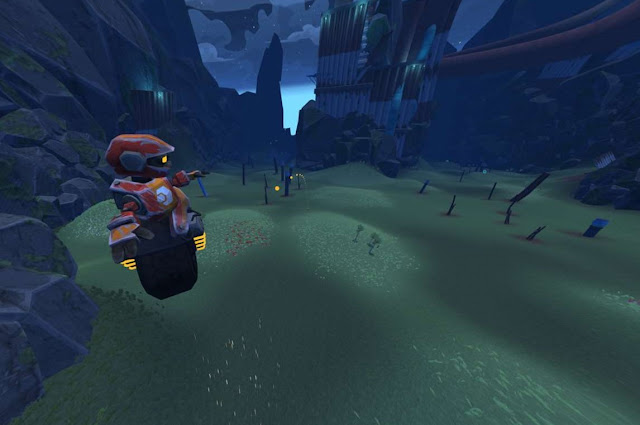Review by Harvard L.
Defunct, from newcomer, Freshly Squeezed, and published by Soedesco, is a momentum-based 3D platformer that’s all about getting through vast and varied levels as fast as possible. With a central mechanic about rolling down steep hills and a level design philosophy that explores elements of platforming, racing and adventure, we have a perfect example of a – everyone say this one with me – 3D Sonic game!
I should clarify, with no means of disrespect to the developers of Defunct, as neither does its game feel derivative of Sonic nor are there any superficial similarities. The only reason I am excited to compare the two is that Defunct is in a perfect position to explore the same territory that Sonic Adventure did, except without the baggage and commercial interest that drove the latter to fail. Defunct is a game that very earnestly tries to figure out how to systemise a high-speed momentum platformer, and even though it feels experimental at times, it sells the fantasy much better than anything else I’ve ever played.
Let’s start with the downright ingenious control scheme. Whereas the Sonic games struggled with creating the sensation of speed and momentum while adhering to traditional platforming controls, Defunct borrows more from the racing genre with its own unique twist. The protagonist in Defunct controls just like a car, with steering left and right and an acceleration button. The catch is that your engine is broken, and accelerating is dreadfully slow – but you can use a gravity modulator to drastically increase your speed going down hills. Skilled players can ride through stages toggling their gravity to pick up some serious speed, and it’s all controlled by one intuitive button and a light on your back that lets you know whether your current slope will speed you up or slow you down.
This control scheme allows Defunct to challenge players with both open-ended levels about reaching a number of goal areas, as well as straight and narrow levels about getting to the end in the fastest time. The former will see you collecting batteries scattered across the landscape to open up a gate to your next area. This is where Defunct feels most like a platformer: you’ll need to use the environment to your advantage and jump off ramps, slopes and banked curves in order to reach the carefully placed batteries. You are given a jump button which can also gently adjust your trajectory a single time in mid-air, but getting to exactly where you want to go will take some getting used to.
Meanwhile, some levels are more closely designed like racing levels, showing off the speed that the game is capable of. These will be downhill obstacle courses with the only goal to reach the end of the level as quickly as possible – and in line with the excellent “Green Hill Zone” design philosophy, the levels are very easy to complete and very difficult to perfect. The game is great at punishing mistakes by slowing the player down, rather than stopping all momentum by giving you a game over screen. The only way to get reset is to ride through water at a slow speed – if you’re quick enough you can even skim the surface of the water to make additional pathways viable.
The best thing the game does is unify its level design and core mechanics to focus on the sensation of high-speed platforming. This is a game which lets the player explore large spaces, navigating weird geography such as loops and corkscrews, without compromising on the desire to go incredibly fast when you want to. It irons away a lot of the issues faced with early 3D platformers in a way that their current day incarnations still struggle with.
To address the most common complaints about the game, Defunct does still struggle with its frame rate and its length. With regards to performance issues, the game tends to stutter when it autosaves on the Switch: for the most part things run well even when the locales the game renders are enormous, but the transitions between levels (which are intended to be seamless in the campaign mode) create a noticeable break of momentum. The game’s length also clocks in at fairly short, and although there is an enjoyable postgame with additional challenges for each level, the overall campaign can be finished in a few hours.
Both issues are comfortably rationalised by the design specifications of the game however – and it perhaps sheds light on why this type of game hasn’t been made on a larger scale. In Defunct, huge rolling fields which would normally be an hour of content in a different game instead rocket by in a fraction of the time. The levels need to be big to facilitate the speed players will be travelling at, but this also hampers production costs. It’s the same reason why most levels after the first in 3D Sonic games tend to be more about slower precision platforming with less emphasis on speed. Defunct on the other hand gets progressively faster as the game goes on, as players become more adept with the gravity based movement, and are also introduced to rechargeable boosts and anti-gravity segments.
Above all else, Defunct sells itself on an exhilarating sense of speed matched with excellent level design and exploration. It’s rare to find a game where simply moving around is as fun as it is here. Of course the game’s short length might deter some, but it’s genuinely interesting to see a developer run with the idea of a momentum-based platformer and nail the core mechanics. At its best moments, Defunct is a playground of movement, and it’s a pure joy to behold.
– Harvard L.
Contributor










